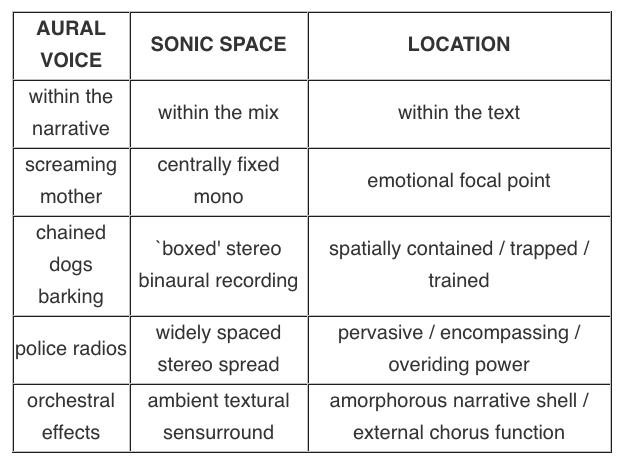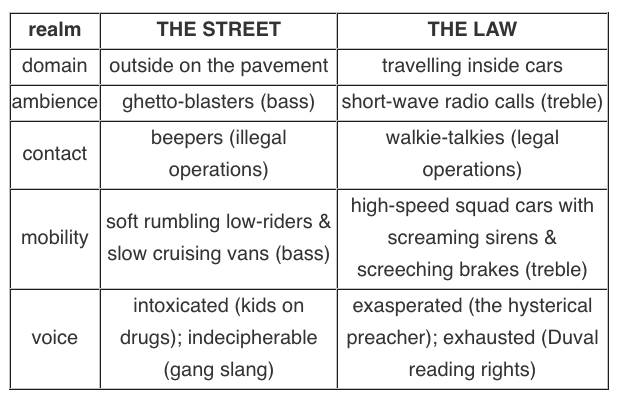 Colors
Colors
Contemporary Traces of the Modern Soundtrack
Developed for RMIT Media ArtsClose analysis
1. Opening title sequence – country and western music, fully produced, played with full frequency range as if diegetic music. Occasional sirens and general traffic ambience matched to shots of LA from a driving police car – the perspective of the polices CRASH anti-gang team. A loud off-screen rattle heard, then loud spray-can sound as red paint sprays across the title COLORS. This sound is placed in the surround channels, lifting the sound off the picture screen.
2. As the song starts to fade, the scenery changes to LA at night shot from a helicopter. The songs is stereo-spatialized with a flamming effect: as if the music is richoeting around the walls of the concrete jungle below.
3. Cut to street level – the terrain of the gangs. Night, dark, silence, no-one around. A metallic bang is heard on this edit, evoking the sound of a manhole cover being struck or a large pipe being dropped. A van approaches from around a corner – flamming/echoing drum beats are heard, the sound of the van’s inside music leaking out into the empty space. The drum track features drum machine textures and occasional metallic tings.
4. Inside the van: the rap song is heard clearer and flatter (without any spatialization). It sounds contained, claustrophobic. A Crips crew are firing up their smokes as they cruise listening to the music, on their way to a hit. Various gang members rap over the bass/drum-machine loop. Sometimes, they speak rhyme/rhythmically, other times in normal speech, but the effect is of their voices becoming one with the song. The song – along with the drugs – is helping them fortify and prep themselves. Through the rap, we are introduced to the characters T-Bone, Rocket, Dog Man, Shotgun Johnson.
5. When the match is struck, the sound is elongated and reverberated: it symbolizes the perceptual ‘time-stretching’ of the crew’s mental state – a mix of paranoid edginess, adrenalin running, and chemical imbalance. Passing cars are also sonically processed in this way – also symbolizing the threat they pose, as the Crips’ van moves further into enemy territory. These latter sounds are more noticeable once the music track is turned off in the van.
6. The van approaches their target house. It hardly makes a sound, just a low soft rumble. Two Bloods’ gang members stand outside talking; the van passes them and Rocket calls “Hey, blood” then blasts his shotgun. The sound is excessively loud and full: this is the sound of being shot, the perspective of having the blast physically alter one’s sense of being. The sound is used to excessively push this dimension of affect.
7. The aftermath of the first shooting: the police tend to the scene while the mother cries.
8. Rocket taken to the police lock-up: the two gangs are interred in adjoining cells. Ice T’s Colors plays. Its functions as 3 types of soundtracks. (a) music soundtrack - composed by MIDI multi-tracking the concept of rhythmic syncopation becomes not simply a musical aesthetic, but also a form of technological synchronization. As determined by the core pulse laid down, all other sonic fragments (beat or otherwise) fall into a line of rhythmic precision. The score is thus less layered and more fused and integrated, according its fragments a location simultaneously in time (the music) and space (the mix).
(b) social soundtrack - the style of the song is more of a lifestyle factor than a formal consideration, as this is the `type' of musical sound to be heard in the actual environments of the scenes represented in the film. As `film music' it communicates more through reference than evocation.
(c) film soundtrack - the song actually contains all the aural elements of the scene it is attached to, for mixed in with the musical arrangement (digital drums, synth bass lines, 3 scratch tracks, strange keyboard sound, Ice-T's voice) are some of the dominant sound effects of the film (gun shots, police sirens, 2-way radios, gang slang, police megaphones - most of which have unironically sampled from movie soundtracks). The point is that the original song - like many `gangster-style' rap tracks - features these `sounds of the urban jungle' in such an iconic fashion. The song is thus a mini-soundtrack for the film, just as the film is an extended-scenario of the song.
9. The community meeting between the police and the local citizens. The sounds of everyone’s voices is hollow – their words blur, and the more they yell the more diffused and illegible their speech. This contained space of the school hall renders their voices powerless symbolically.
10. The funeral of the recently shot Bloods’ gang member. The small church musical group sings a Baptist song. The congregation is silent and not participating. A Bloods’ crew is also present. The preacher takes the pulpit and ‘performs’ his oratory while the piano player plays backing chords. The rest of the group provide the response tags to the preacher’s tagged calls and questions. Whereas Baptist music is often presented in US movies as a fulsome sign of community integration, here it is presented as flat and shallow: the mourning congregation are not visibly effected – the sound of the preacher’s voice is more theatrical than genuine. Suddenly, extremely loud gunfire is heard as the windows are shattered by a Crips’ drive-by. The sound and presence of these gunshots decimates the aural level of the Baptist gathering – the guns speak much louder than the preacher’s words.
11. The police chase the church shooting crew. The score percolates underneath – mostly drum machines and digital keyboards. Loud sound effects are mixed high with the music. After the final crash and car explosion, the music adds a swirling keyboard texture, panning left to right. The score was tracking with the chasing cars – keeping locked to their positioning, but once the deaths occur, the music transfigures space, and becomes decentralized.
12. The Latino gang gathered in their hang-out. The space is large and reverberant, but open to the elements. Inside atmosphere combines with internal acoustics: the space is indoors and outdoors. Ex-gang member Ron is trying to talk the gang out of continuing their violent ways: he is an intermediary, yet the gang acknowledges that they are caught in the gang cycle. Like the space and the ex-gang member, they are inside and outside. The location recording of their non-post dubbed voices captures this texture.
13. When Hodges, McGavin and the sheriff start their approach to the drug house bust, the score kicks in, percolating again underneath as in 11. This diegetic music is ‘scored Electro’ beats, representing not the street culture which produced Electro, but the power of the police and their mechanisms in enforcing societal laws. The music is imbued with a type of ‘sonic authority’. Similar music returns when the helicopter approaches the bust site once the drug bust has been completed.
14. More ‘sonic authority’ music when Hodges and McGavin chase High-Top through Venice Beach.
15. McGavin working out in the gym after the High-Top arrest – he plays FM rock loudly on a ghetto blaster. His character has no connection with the musical culture of the streets he patrol.
16. When the police attempt to track down Rocket’s girlfriend, they come across another guy in bed with her. She is screaming orgasmically while break-dance electro beats boom loudly. This soundscape of booms and moans is changed once he is shot by officer Baines: after the loud gunshots fired by one of the policeman, the tape player is stopped, the girl is crying and screaming, dogs bark in the distance, the guy’s last words are gasped softly. This is a variation of the shooting in 7.
17. Rocket’s hide-out is a derelict house. Rocket and other Crips lay low planning to shoot McGavin. The rooms are dark like the drive-by van; music plays in this claustrophobic space – no reverb or echo, the sound is airless as in 4.
18. At the Latino party, funky music plays. Rocket and his crew drive-by – their van is a low rumble as in 6. The open fire on the house with Uzis: extremely loud gunfire.
19. After the police arrive at the party’s aftermath, McGavin discovers Louisa after she had been making out with a Latino gang member. He is shocked: light electro drum machines and synth chords play, down tempo, space-out. This slightly mournful theme carries over into Hodges discovering an innocent girl’s bullet-ridden body in the house next door to the party. The father is heard crying; Hodges talks softly asking one of the witnesses; the rim shots echo loudly out of the music mix.
20. Long shot of the Latino gang marching down a laneway. Herbie Hancock score plays fully – the song is based on Latino electro stylings from the time.
21. In a reversal of 4-6, the Latinos approach Rocket’s Crips hide-out. Inside, music plays loudly; outside it is echoic; the Latino car cruises by with a faint low rumble; random industrial clanging is heard in the outside street atmosphere. Then the gunfire opens: extremely loud and continual. Digital keyboard stabs and staccato echoed bongos are mixed amongst the shots. After Larry and Rocket shoot each other dead, the Latino car drives off. Only soft atmosphere is heard: no-one mourns either side – there are no winners.
22. The Latino gang regroup on a hilltop overlooking the city lights. They play acoustic guitar (Latino folk) and chill out.
23. The police surround them: chopper sounds, police yelling, loud distorting speaker horn. The chopper drones, creating tension to the scene. Suddenly a gang member shoots Hodges. No music or additional sound is introduced. The chopper keeps droning. All sound softens slightly – we hear Hodges gasping and McGavin whispering to him. Hodges’ panting and sobbing is clearly audible. Throughout this, a faint dissonant drone creeps into the background. Hodges dies. McGavin screams out “Nooo!” His voice morphs with a sheet of pink noise; a dissonant electronic chord swirls loudly; deep slowed-down thumps are heard; the walkie-talkies distort loudly. Sheets of white noise and synthesizers are overlaid with the whirling chopper as the camera cranes up high above Hodges’ body. This strange amalgam of sound elements symbolises the spirit of Hodges departing the mortal plane. It also synchronises to the anguish cathartically released by McGavin who has held Hodges while he died.
24. A hard cut to the next day – the Watts Towers. A synthetic ‘scream’ effect echoes across this shot, like the overlay from waking up from a nightmare. A travelling car point-of-view shows the full Watts Towers sculpture. No atmosphere is audible.
Text © Philip Brophy.



